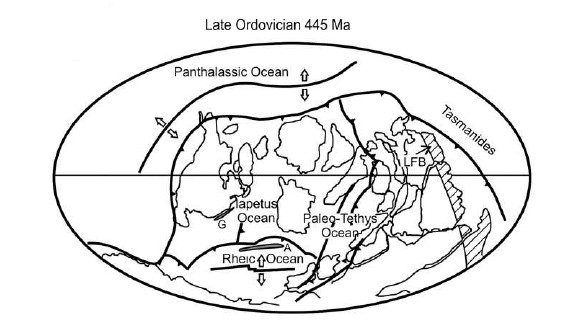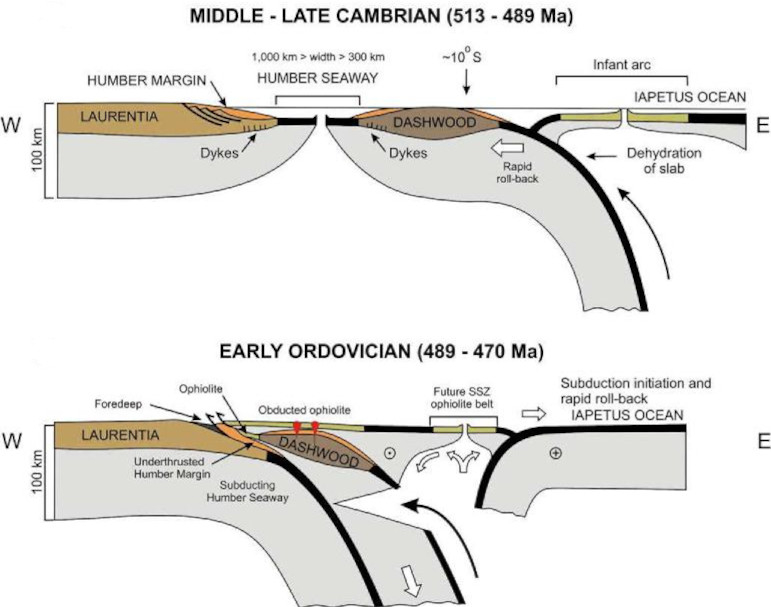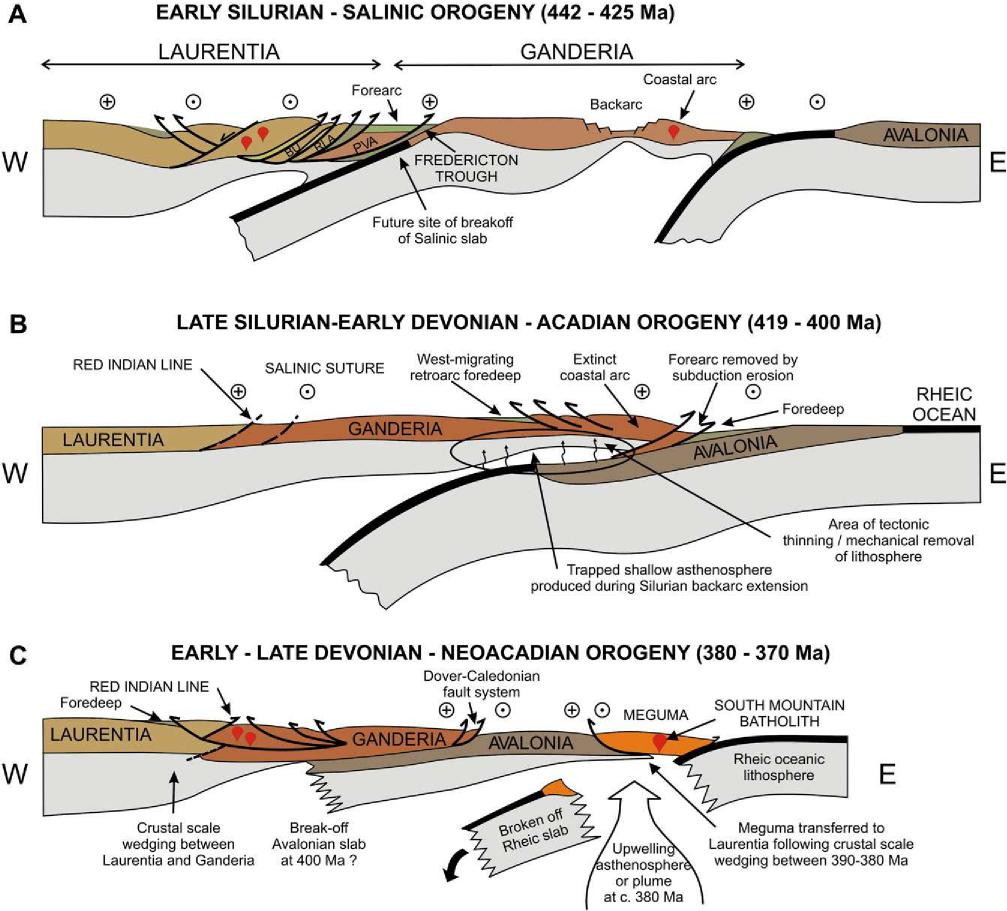This post is a summary of the interesting paper on the geodynamic relationships between Paleozoic arc development along the flanks of the interior (e.g. the Iapetus and Rheic) oceans and the exterior Paleopacific Ocean. Murphy, B., van Staal, C and Collins, W, A comparison of the evolution of arc complexes in Paleozoic interior and peripheral orogens: Speculations on geodynamic correlations, Gondwana Research, 2011. doi:10.1016/j.gr.2010.11.019.
Summary
- This paper discusses the geodynamic relationships between Paleozoic arc development along the flanks of the interior (e.g. the Iapetus and Rheic) oceans and the exterior Paleopacific Ocean.
- Paleozoic arcs in the Iapetus and Rheic oceanic realms are preserved in the Appalachian–Caledonide and Variscan orogens, and in the Paleopacific Ocean realm they are preserved in the Terra Australis Orogen.
- Paleocontinental reconstructions show Cambrian–Early Ordovician contraction of the exterior ocean as the interior oceans expanded and subsequent Paleozoic expansion of the exterior oceans while the interior oceans contracted.

- Subduction initiated in the eastern segment of Iapetus at ca. 515 Ma and Early to Middle Ordovician orogenesis along the flanks of this ocean is highlighted by arc–continent collisions and ophiolite obductions.

- Over a similar time interval, subduction and orogenesis took place in the exterior ocean and included formation of the Macquarie arc in the Tasmanides of Eastern Australia and the Famatina arc and correlatives in the periphery of the proto-Andean margin of Gondwana and correlatives in the periphery of the proto-Andean margin of Gondwana
- Major changes in the style of subduction (from retreating to advancing) in interior oceans occurred during the Silurian, following accretion of the peri-Gondwanan terranes and Baltica, and closure of the northeastern segment of Iapetus.

- During the same time interval, subduction in the Paleopacific Ocean was predominantly in a retreating mode, although intermittent episodes of contraction closed major marginal basins.
- Major disturbances in the Earth tectonic systems during the Ordovician, including an unprecedented rise in marine life diversity, as well as significant fluctuations in sea level, atmospheric CO2, and 87Sr/86Sr and 13C in marine strata carbonates.
- Stable and radiogenic isotopic data provide evidence for the addition of abundant mantle-derived magma, fluids and large mineral deposits that have a significant mantle-derived component.
- The authors speculate that the emergence of a superplume triggered by slab avalanche events within the Iapetus and Paleopacific oceans was associated with the establishment of a new geoid high within the Paleopacific tectonic regime.
- Closure of the interior Rheic Ocean and the amalgamation of Laurussia and Gondwana was a key event in the Late Carboniferous amalgamation of Pangea.
Introduction
In the classical Wilson cycle, oceanic crust generated during supercontinent breakup is consumed during subsequent amalgamation so that the supercontinent turns “inside in” (introversion). Alternatively, following supercontinent breakup, the exterior margins of the dispersing continental fragments collide during reassembly so that the super-continent turns “outside in” (extraversion).
Irrespective of whether a supercontinent forms by introversion or extroversion, orogenic activity attending the assembly and amalgamation of a supercontinent typically occurs by subduction-related then collisional orogenesis, with the resulting orogenic belts occurring in the interior of the supercontinent, known as interior orogens. Elimination of subduction zones between the colliding blocks results in their relocation to the periphery of the supercontinent, resulting in peripheral orogens, a general term to describe all types of activity along the periphery of supercontinents, including orogenesis due to subduction and accretionary processes.
The final breakup of the supercontinent Rodinia between 650 and 540 Ma is a manifestation of fundamental changes to global plate motions during the Late Neoproterozoic New oceanic lithosphere developed between the diverging plates leading to the development of interior oceans. At about the same time (Early Cambrian), Gondwana became completely amalgamated and subduction commenced in the exterior (paleo-Pacific) ocean, evidence of which is preserved in the 18,000 km long Terra Australis orogen (TAO).
By the end of the Early Cambrian (ca. 515 Ma), subduction had commenced in the interior Iapetus Ocean along both of its margins. Although punctuated by obduction of oceanic lithosphere and several episodes of terrane accretion, subduction continued more-or-less continuously in the interior oceans throughout the remainder of the Paleozoic, culminating in Late Paleozoic terminal collision and the amalgamation of Pangea. Similarly, the TAO preserves evidence of subduction adjacent to the flanks of the exterior paleo-Pacific ocean. Beginning locally at ca. 580 Ma, subduction was established along the entire length of the TAO by 550 Ma and continued until ca. 230 Ma
In the classical Wilson cycle, oceanic crust generated during supercontinent breakup is consumed during subsequent amalgamation so that the supercontinent turns “inside in” Alternatively, following supercontinent breakup, the exterior margins of the dispersing continental fragments collide during reassembly so that the super-continent turns “outside in” Irrespective of whether a supercontinent forms by introversion or extroversion, orogenic activity attending the assembly and amalgamation of a supercontinent typically occurs by subduction-related then collisional orogenesis, with the resulting orogenic belts occurring in the interior of the supercontinent, known as interior orogens. Elimination of subduction zones between the colliding blocks results in their relocation to the periphery of the supercontinent, resulting in peripheral orogens, a general term to describe all types of activity along the periphery of supercontinents, including orogenesis due to subduction and accretionary processes.
The final breakup of the supercontinent Rodinia between 650 and 540 Ma is a manifestation of fundamental changes to global plate motions during the Late Neoproterozoic New oceanic lithosphere developed between the diverging plates leading to the development of interior oceans. At about the same time (Early Cambrian), Gondwana became completely amalgamated and subduction commenced in the exterior (paleo-Pacific) ocean, evidence of which is preserved in the 18,000 km long Terra Australis orogen.
By the end of the Early Cambrian (ca. 515 Ma), subduction had commenced in the interior Iapetus Ocean along both of its margins. Although punctuated by obduction of oceanic lithosphere and several episodes of terrane accretion, subduction continued more-or-less continuously in the interior oceans throughout the remainder of the Paleozoic, culminating in Late Paleozoic terminal collision and the amalgamation of Pangea. Similarly, the TAO preserves evidence of subduction adjacent to the flanks of the exterior paleo-Pacific ocean. Beginning locally at ca. 580 Ma, subduction was established along the entire length of the TAO by 550 Ma and continued until ca. 230 Ma.
References
Murphy, B., van Staal, C and Collins, W, A comparison of the evolution of arc complexes in Paleozoic interior and peripheral orogens: Speculations on geodynamic correlations, Gondwana Research, 2011. doi:10.1016/j.gr.2010.11.019.